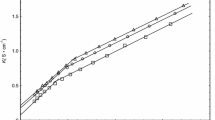Summary
The properties of a series of ionic ethoxylated surfactants of the typeR m (OC2H4) χ SO4Na andR m (OC2H4) χ TAB (m = 10, 12, 14 or 16 andx = 0, 1, 2 or 3) were studied. Surface areas obtained from surface tension measurements increased as the ethoxy group number increased whereas increasing the hydrocarbon chain length had little effect. The c.m.c.'s obtained from conductivity decreased with increase in hydrocarbon chain length and to a smaller extent as the ethoxy group number increased. Values ofΔG° showed the methylene group to be four fold as effective as the ethoxy group in promoting micellisation. As the temperature was varied between 5 and 60 °C all the surfactants exhibited a minimum c.m.c. value close to 25 °C which decreased as the surfactant became more hydrophobic and increased as the surfactant became more hydrophilic. Counterion binding from specific ion electrode measurements increased with increase in hydrocarbon chain length but decreased with increase in ethoxy group number. Counterion binding decreased with increase in temperature.
Zusammenfassung
Die Eigenschaften einer Reihe ionischer äthoxylierter oberflächenaktiver Stoffe vom TypR m (OC2H4) χ SO4Na undR m (OC2H4) χ TAB (m = 10, 12, 14 oder 16 undx = 0, 1, 2 oder 3) wurden untersucht. Die bei der Messung der Oberflächenspannung ermittelten Werte verzeichneten eine Zunahme bei der Zunahme der Äthoxy-Gruppe, wohingegen die Verlängerung der Kohlenwasserstoffkette keine nennenswerten Auswirkungen zeigte. Die durch Leitfähigkeit erhaltenen c.m.c.'s verringerten sich bei der Verlängerung der Kohlenwasserstoffkette und, in etwas geringerem Maße, beim Anwachsen der Äthoxy-Gruppe. Meßwerte vonΔG° deuteten darauf hin, daß die Methylengruppe in der Steigerung der Micellisierung um das Vierfache wirksamer war als die Äthoxy-Gruppe. Zwischen 5° und 60° zeigten alle untersuchten oberflächenaktiven Stoffe ein Minimum im c.m.c.-Wert in der Nähe von 25°, das sich verringerte, wenn diese Stoffe hydrophober wurden, und zunahm, wenn sie hydrophiler wurden. Die Bindung von Gegenionen, die aus Messungen mit spezifischen Ionenelektroden gewonnen wurde, steigerte sich mit zunehmender Länge der Kohlenwasserstoffkette, aber ging zurück mit zunehmender Zahl der Äthoxy-Gruppen. Die Bindung von Gegenionen verringerte sich mit steigender Temperatur.
Similar content being viewed by others
References
Weil, J. K., R. G. Bistline, A. J. Stirton, J. Phys. Chem.62, 1083–1085 (1958).
Schick, M. J., J. Phys. Chem.68, 3585–3592 (1964).
Tokiwa, F., J. Phys. Chem.72, 1214–1217 (1968).
Tokiwa, F., K. Ohki, J. Phys. Chem.71, 1343–1348 (1967).
Attwood, D., Kolloid-Z. u. Z. Polymere232, 788–792 (1969).
Attwood, D., Kolloid-Z. u. Z. Polymere235, 1193–1195 (1969).
Attwood, D., A. T. Florence, Kolloid-Z. u. Z. Polymere246, 580–586 (1971).
von Gotte, E., 3rd International Concress of Surface Activity1, 45–50 (1960).
Groves, M. J., R. M. A. Mustafa, J. E. Carless, J. Pharm. Pharmac.25, 736–740 (1973).
Mulley, B. A., J. Chem. Soc. 2065–2066 (1958).
Wiley, G. A., R. L. Hershkowitz, B. M. Rein, B. C. Chung, J. Am. Chem. Soc.86, 964–965 (1964).
Harkins, W. D., H. F. Jordan, J. Amer. Chem. Soc.52, 1751–1772 (1930).
Tajima, K., M. Muramatsu, T. Sasaki, Bull. Chem. Soc. Japan43, 1991–8 (1970).
MacInnes, D. A., in: The principles of electrochemistry (New York 1961).
Botré, C., V. L. Crescenzi, A. Mele, J. Phys. Chem.63, 650–653 (1959).
Ingrain, T., M. N. Jones, Trans. Farad. Soc.65, 297–304 (1969).
Shedlovsky, L., C. W. Jakob, M. B. Epstein, J. Phys. Chem.67, 2075–2079 (1963).
Phillips, J. N., K. J. Mysels, J. Phys. Chem.59, 325–330 (1955).
Pearson, J. T., K. J. Humphreys, J. Pharm. Pharmac.22, 126–130S (1970).
Padday, J. F., J. Phys. Chem.71, 3488–3493 (1967).
Meakins, R. J., M. G. Stevens, R. J. Hunter, J. Phys. Chem.73, 112 (1969).
Klevens, H. B., J. Amer. Oil Chemists Soc.30, 74–80 (1953).
Shinoda, K., Colloidal Surfactants (New York 1963).
Tanford, C., The hydrophobic effect: formation of micelles and biological membranes (New York 1973).
Corkill, J. M., J. F. Goodman, S. P. Harrold, Trans. Farad. Soc.60, 202–207 (1964).
Barry, B. W., G. F. J. Russell, J. Coll. Interf. Sci.40, 174–194 (1972).
Evans, H. C., J. Chem. Soc. 579–586 (1956).
Feinstein, M. E., H. L. Rosano, J. Coll. Interf. Sci.24, 73–79 (1967).
Handbook of Chemistry and Physics, 46th ed. (Ohio 1965).
Barry, B. V., R. Wilson, Micellar molecular weights and hydration of ethoxylated anionic and actionic surfactants. Kolloid-Z. u. Z. Polymere.
Author information
Authors and Affiliations
Additional information
With 7 figures and 4 tables
Rights and permissions
About this article
Cite this article
Barry, B.W., Wilson, R. C. M. C., counterion binding and thermodynamics of ethoxylated anionic and cationic surfactants. Colloid & Polymer Sci 256, 251–260 (1978). https://doi.org/10.1007/BF01550555
Received:
Issue Date:
DOI: https://doi.org/10.1007/BF01550555



